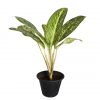Zebra Haworthia succulent Plant
₹490.00
Zebra Haworthia succulent Plant is great for your home or office desk or indoor succulent garden. It is a favourite household succulent even for beginners because of its ability to tolerate low light and easiness of maintenance. Above all, this cute plant rarely affected by common succulent pests and diseases. in fact, this slow-growing zebra plant is particularly hard to kill. It also propagates easily, which makes it perfect for arrangements or gifts.
Plant size 3-4 inches (5 – 10 cm) tall
Pot size – 7-10 cm (H)
Zebra Haworthia succulent Plant is great for your home or office desk or indoor succulent garden. It is a favourite household succulent even for beginners because of its ability to tolerate low light and easiness of maintenance. Above all, this cute plant rarely affected by common succulent pests and diseases. in fact, this slow-growing zebra plant is particularly hard to kill. It also propagates easily, which makes it perfect for arrangements or gifts.
The Zebra Haworthia forms a rosette of leaves. Its triangular-shaped thick green leaves have white bumps like strips on the outsides which resembles a zebra. The species has similar markings to Haworthia attenuata. The two are therefore frequently confused with each other. It is also commonly mistaken for Aloe vera.
Scientific Name: Haworthiopsis Fasciata
Common Name: Zebra Plant, Zebra Haworthia, Haworthia fasciata
Family: Xanthorrhoeaceae
Flowering: Blooms in the Summer (may not indoors). Small tubular white or pink flowers that grow on a tall, thin stem.
Benefit: Air Purifier
Zebra Haworthia Care
Unlike other succulents, it is important not to over-water or fertilize Zebra Plant during summer dormancy and water more frequently in the winter growing season.
Light: Partial/filtered sun or Low Indoor Light. Direct sun can burn the leaves. Leaves will turn into white or Yellow.
Soil: Use well-drained soil and provides plenty of air to the small roots. Use a cactus mix or potting soil mixed with perlite and sand.
Water: Water once every two weeks, letting the soil media dry out between waterings in the summer. In the winter, reduce watering to every other month. Zebra plant’s leaves are storage organs and roots are drought-tolerant. Root will grow if they have great drainage and deep, infrequent water when the soil is fully dry. Never allow water to gather in the rosette. Avoid water it daily. Water them more in spring and summer and less in winter.
Temperature: Normal room humidity will suffice. 65°F – 80°F (8°C – 26°C) temperatures are very good and not below 50°F (10°C).
Fertilizer: During summer you can feed Zebra Plants with a diluted liquid fertilizer/cactus fertilizer once every month. Do not feed during winter.
Repotting: Once the Zebra Plant outgrows the pot you can re-pot, during spring. Only move to a slightly bigger pot. Every two years I would renew the soil even if re-potting is not required.
Propagation: Zebra Plants are propagated by leaves cutting or through the pups or offsets which can be removed from the mother plant.
Toxicity: Non-toxic to humans and animals.
| Weight | 250 g |
|---|---|
| Dimensions | 7 × 7 × 7 cm |
Be the first to review “Zebra Haworthia succulent Plant” Cancel reply
You must be logged in to post a review.
This site uses Akismet to reduce spam. Learn how your comment data is processed.
You may also like…
Related products
Foliage Plants
Feng Shui Plants
Foliage Plants
Feng Shui Plants
Feng Shui Plants































Reviews
There are no reviews yet.